Novak Djokovic Captures His Second Australian Open Crown
2007
Remember the U.S. Open in 2007?
Remember how happy Novak Djokovic was and how happy he made the New York crowds with his impersonations of the top players like Maria Sharapova, Andy Roddick, Roger Federer and even Rafael Nadal?
While the guys growled, seemingly a little scratchy about his antics, Sharapova loved it and even sat in the Serb’s box with his parents! Life was good then, Nole. Wasn’t it? Simple, but good.
Djokovic made it all the way to the finals, where he faced Federer down. The Serb lost, of course. Nerves. Actually, he lost in straight sets, but the match was closer than it looked on paper. That’s what everybody said, anyway.
After mixed reviews, Nole faded fast in the 2007 fall indoor season—tired no doubt from all that instant fame and the rocket-ride to the top of the men’s game at age 20. He could barely hold up a racket during the Masters Championship in Shanghai. Noticeably, he didn’t win a rubber.
Extreme fatigue.
2008
By the Australian Open in 2008, Nole was ready to roll again.
He did that by powering his way through to the final.
In the process, he defeated his former foe, Federer.
This time, Djokovic won in straight sets and sent the shocked Fed man home without a trophy. This took place in the semifinals, as Jo-Willy Tsonga was doing something similar to Nadal.
The culmination of this epic victory will forever be marked by the utterance of Nole’s sweet old mom, who cried out, “The king is dead!”
This, of course, referenced the newly-deposed Roger Federer. Such remarks endeared her forever to the legion of Federer fans.
In the final, the Serb swept Tsonga aside, the Frenchman overcome by the occasion. Djokovic had won his first Grand Slam tournament, and, according to the pundits, there would be many more trophies gathering dust on his mantle before his career was over.
The victory marked the beginning. Following months seemed to punctuate the Serb’s early success. Djokovic won Master’s Series tournaments in Indian Wells on hardcourts and in Rome on clay.
He closed in on Nadal, constantly nipping at his heels, but Djokovic could never surpass the No. 2 player, even though many speculated that soon Nadal would fade away. That is ironic when you think about what really happened.
Because after Rome, Djokovic began to fade. The Serb mysteriously quit in a match with Federer in Monte Carlo. This occurred after Federer apparently shushed Nole’s parents during the match.
Djokovic’s reputation began to unravel. He was criticized for his rush to retirements when he was losing.
The Serb made it to the semis of Roland Garros, but was dismissed early at Wimbledon by Safin. His early defeat registered as a real shocker, especially after much musing about how important Djokovic was to the “triumvirate” at the top of the men’s game.
Djokovic met Federer again—this time in the semifinals of the U.S. Open. He lost in four sets, 6-3, 5-7, 7-5, 6-2. During the match, Djokovic seemed a bit shell-shocked and timid.
At the conclusion of this match, there were no comments by Nole’s mom.
In fact, this time, Djokovic did his own damage by berating the New York crowd for supporting Roddick, who had poked fun at the list of all of Nole’s supposed ailments prior to their quarterfinal match. The New Yorkers did not take well to his scolding and booed him.
If you look at the year between the 2007 U.S. Open and 2008, Djokovic dipped. His confidence seemed to drop off the chart.
He was still ranked No. 3, but prospects did not appear quite as rosy as they did in 2007. Andy Murray subsequently forced himself into the group as a member of the top four, as the Scot was closing in fast on the No. 3 spot.
Even after winning the year-end championships in 2008, Djokovic was pretty much the forgotten man at the start of 2009.
2009
In January, at the Medibank International in Sydney, all the Serb had to do was defeat Jarkko Nieminen in the semifinals and he would have been the No. 2 tennis player in the world.
But he lost, letting Federer off the hook. Another golden opportunity wasted.
As defending champion at the Australian Open, Djokovic had to retire in the quarterfinals against Roddick—the man who had speared him with his comments in New York.
At this point, the criticism for his actions came from on high, as even Federer noted that Djokovic had retired in three of four Grand Slam tournaments.
For the rest of the year at Masters Events, Djokovic became the best man—coming in second—to Andy Murray in Miami, to Rafael Nadal in Monte Carlo and in Rome.
After Rome, he dropped to the No. 4 ranking while Nadal retained his grip on the No. 1 spot.
When the season headed indoors for the remainder of 2009, Djokovic began to make his move on the field. He won the China Open and once again reigned as the No. 3 player in the world, knocking Murray back down.
At the Shanghai Masters, he lost in the semifinals to eventual champion Nikolay Davydenko, but then went on to steal away Federer’s home tournament in Basel, defeating the Swiss in the final.
To capitalize on his improving status, Djokovic captured the final Masters tournament of the year in Paris, defeating Frenchman Gael Monfils in the final.
Subtle traces of maturity surfaced, as the good-humored demeanor returned to the very talented Serb’s repertoire. The world still awaited the promise the 20-year-old exhibited in 2007.
2010
The year started off well as the Serb ascended to the No. 2 ranking, even after losing in the Kooyong Classic to Fernando Verdasco and after being dispatched by Bernard Tomic in an exhibition.
Djokovic lost in the quarterfinals of the Australian Open to the man he defeated in the finals in 2007, Jo-Willy Tsonga.
It seemed as if the Serb began to turn things around by defending his title in Dubai. The rise to winning came to an abrupt halt in Indian Wells and Miami, where Djokovic lost in the fourth and first rounds, respectively.
At that juncture the Serb dismissed coach Todd Martin, who had been helping Djokovic tinker with his service motion, the serve now often deserting him as he piled up double faults during his matches.
The clay season was fraught with disappointments and allergy complaints, ending with a quarterfinal loss at the French Open in five sets to resurgent Jurgen Melzer. At Wimbledon, Djokovic advanced to the semifinals before succumbing to Tomas Berdych in straight sets.
The summer hard-court season in America offered nothing to inspire the Serb. But the 2010 U.S. Open finally gave Djokovic the turning point he had been seeking all along during the semifinals against Roger Federer.
It was the Swiss who had beaten him in the last four U.S. Open tournaments. In fact, it was the first time the Serb had gotten past the semifinals of a major since 2008. Djokovic would go on to lose to Rafael Nadal in the final. But this U.S. Open began a new era for the Serb.
Djokovic defended his title in the China Open after helping Serbia secure a spot in the upcoming Davis Cup final. He lost in the semifinals to Roger Federer in Shanghai and in the semifinals of the Barclays World Tour Finals in London.
Still, his belief was intact. He could win against Federer in the majors, he was positive of that. Djokovic ended the year ranked No. 3 for the fourth year.
2011
During the offseason, Djokovic committed himself to winning by getting in great shape, working diligently on his fitness while perfecting his once aberrant serve.
After teaming with Ana Ivanovic in the Hopman Cup, Djokovic entered the Australian Open.
The Serb remained barely in the conversation as media attention remained riveted on Rafa reaching and winning his fourth consecutive grand slam final, the Rafa Slam. Or Roger Federer reclaiming the championship and winning his fifth Aussie Open title.
Djokovic marched through his matches after stumbling a bit getting out of the blocks. The Serb defeated Marcel Granollers in the opener but was extended to four sets against Croat Ivan Dodig.
After that point, Djokovic did not surrender a set. He took out Viktor Troicki, Nicholas Almagro, Tomas Berdych and Roger Federer in the semifinals.
Finally he defeated his friend and frequent practice partner Andy Murray 6-4, 6-2, 6-3 in the finals. Djokovic won his second title Down Under and his second Grand Slam title.
The fun-loving, carefree guy didn’t handle his instant fame well back in 2007. He took his personal life with him onto the court. When potential continues to override commitment, hard work is set aside. You can never rise to the top on talent alone. Now Djokovic seems at long last to have figured out his priorities.
Djokovic has natural talent to burn. He moves better and serves better than most at the top of the game.
At last these tools are going to take him out of being third best, but the question remains—just how high will he rise?
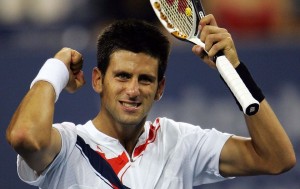
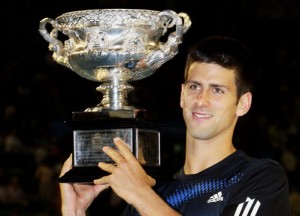
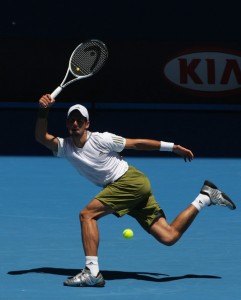
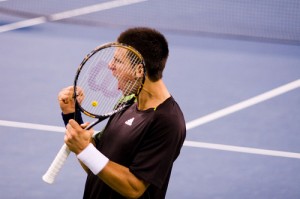
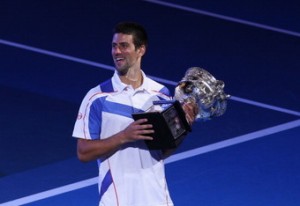
mlfecg
I’ll right away grab your rss as I can not find your e-mail subscription hyperlink or e-newsletter service. Do you’ve any? Please allow me recognize in order that I may subscribe. Thanks.
Awesome post ! Thank you for, posting on this blog page mate. Ill email you soon. I didnt realise that!
Weird , this page turns up with a dark color to it, what color is the primary color on your site?
hi how are you are you fine now?
For getting the updates related with every type of sport this website has been the best place for me to visit. I really want to admire the person that is being running this website.
surely just like your web-site nevertheless you must check the particular transliteration upon some of your posts. Many of them are rife together with punctuational challenges and i also still find it very troublesome to express to the facts conversely We’ll surely go back once again. surely just like your web-site nevertheless you must check the particular transliteration upon some of your posts. Many of them are rife together with punctuational challenges and i also still find it very troublesome to express to the facts conversely We’ll surely go back once again.